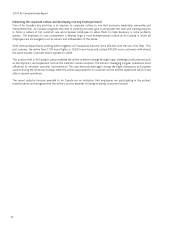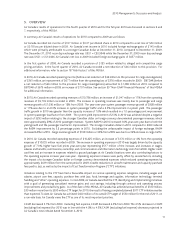Air Canada 2010 Annual Report Download - page 20
Download and view the complete annual report
Please find page 20 of the 2010 Air Canada annual report below. You can navigate through the pages in the report by either clicking on the pages listed below, or by using the keyword search tool below to find specific information within the annual report.
2010 Air Canada Annual Report
20
(2) Excludes early terminated hedging contracts of $20 million in the fourth quarter of 2009 covering 2010 fuel consumption. Includes net cash settlements on maturing
fuel derivatives and premium costs associated with those derivatives.
(3) The economic cost of fuel is a non-GAAP measure used by Air Canada and may not be comparable to measures presented by other public companies. Air Canada uses
this measure to calculate its cash cost of fuel. It includes the actual net cash settlements from maturing fuel derivative contracts during the period and premium costs
associated with those derivatives. It excludes non-cash accounting gains and losses from fuel derivative instruments.
Wages, salaries and benefits expense amounted to $470 million in the fourth quarter of 2010, an increase of $52
million or 12% from the fourth quarter of 2009
Wages and salaries expense amounted to $401 million in the fourth quarter of 2010, an increase of $39 million or 11%
from the fourth quarter of 2009. This increase was mainly due to higher expenses related to incentive compensation
programs linked to Air Canada’s financial and operational performance.
Employee benefits expense amounted to $69 million in the fourth quarter of 2010, an increase of $13 million or 23%
from the fourth quarter of 2009. The increase in employee benefits expense was mainly due to higher pension expense as
a result of changes in actuarial assumptions. For information on Air Canada’s pension funding obligations, refer to section
9.8 of this MD&A.
Airport and navigation fees increased $1 million from the fourth quarter of 2009
Airport and navigation fees amounted to $229 million in the fourth quarter of 2010, an increase of $1 million. The
impact of a 4.2% increase in aircraft departures was mostly offset by lower rates for landing and general terminal fees,
mainly at Toronto Pearson International Airport, and the favourable impact of a stronger Canadian dollar versus the U.S.
dollar compared to the fourth quarter of 2009 on U.S. and other foreign currency denominated airport and navigation fee
expenses.
Capacity purchase costs with Jazz increased $4 million from the fourth quarter of 2009
Capacity purchase costs with Jazz, pursuant to the Jazz CPA, amounted to $231 million in the fourth quarter of 2010
compared to $227 million in the fourth quarter of 2009, an increase of $4 million or 2%. This year-over-year increase in
capacity purchase costs was mainly due to an increase in Jazz CPA rates of $10 million, including $3 million related to
additional maintenance costs due to the aging of Jazz’s fleet, and $7 million as a result of increased flying. Largely offsetting
these increases was the impact of the CTP-related amendment to the Jazz CPA effective August 1, 2009, which accounted
for a decrease of $5 million, the favourable impact of foreign exchange on U.S. currency denominated Jazz CPA charges
paid by Air Canada, which accounted for a decrease of $3 million and other factors which accounted for a net decrease of
$5 million.
Ownership costs decreased $1 million from the fourth quarter of 2009
Ownership costs, comprised of depreciation and amortization, and aircraft rent expense, of $249 million in the fourth
quarter of 2010 decreased $1 million from the fourth quarter of 2009. The decrease included the favourable impact of a
stronger Canadian dollar versus the U.S. dollar, which accounted for a decrease of $4 million to aircraft rent expense.
(Canadian dollars in millions, except
where indicated)
Fourth Quarter Change
2010 2009 $%
Aircraft fuel expense - GAAP (1) $ 636 $ 599 $ 37 6
Remove: Fuel hedging gains (losses) reclassified from
AOCL into fuel expense (31) (85) 54 64
Add: Net cash payment on fuel derivatives (2) 7 12 (5) (42)
Economic cost of fuel - Non-GAAP (3) $ 612 $ 526 $ 86 16
Fuel consumption (thousands of litres) 905,519 824,911 80,608 10
Fuel cost per litre (cents) - GAAP 70.2 72.6 (2.4) (3)
Fuel cost per litre (cents) - excluding fuel hedging gains
(losses) 66.8 62.3 4.5 7
Economic fuel cost per litre (cents) - Non-GAAP 67.5 63.7 3.8 6
(1) Excludes fuel expense related to third party carriers, other than Jazz, operating under capacity purchase agreements.
The table below provides Air Canada’s fuel cost per litre, excluding and including hedging, for the periods indicated.
























